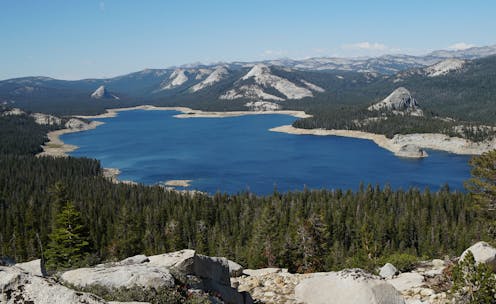California's water supplies are in trouble as climate change worsens natural dry spells, especially in the Sierra Nevada
- Written by Roger Bales, Distinguished Professor of Engineering, University of California, Merced

California is preparing for a third straight year of drought, and officials are tightening limits on water use to levels never seen so early in the water year. Most of the state’s water reservoirs are well below average[1], with several at less than a third of their capacity. The outlook for rain and snow this winter[2], when most of the state’s yearly precipitation arrives, isn’t promising.
Especially worrying is the outlook for the Sierra Nevada, the long mountain chain that runs through the eastern part of the state. California’s cities and its farms – which grow over a third of the nation’s vegetables[3] and two-thirds of its fruit and nuts – rely on runoff from the mountains’ snowpack for water.
As an engineer[4], I have studied California’s water and climate for over 30 years. A closer look at California’s water resources shows the challenge ahead and how climate change is putting the state’s water supply and agriculture at greater risk.
Where California gets its water
Statewide, California averages about 2 feet of precipitation per year, about two-thirds of the global average, giving the state as a whole a semi-arid climate.
The majority of California’s rain and snow falls in the mountains, primarily in winter and spring. But agriculture and coastal cities need that water to get through the dry summers. To get water to dry Southern California and help with flood control in the north, California over the past century developed a statewide system[5] of reservoirs, tunnels and canals that brings water from the mountains. The largest of those projects, the State Water Project, delivers water from the higher-precipitation northern Sierra to the southern half of the state.
To track where the water goes, it’s useful to look at the volume in acre-feet. California is about 100 million acres in area, so at 2 feet per year, its annual precipitation averages about 200 million acre-feet.
Of that 200, an average of only about 80 million acre-feet heads downstream. Much of the water returns to the atmosphere through evapotranspiration[6] by plants and trees in the Sierra Nevada or North Coast forests. Of the 80 million acre-feet that does run off, about half remains in the aquatic environment, such as rivers flowing to the ocean. That leaves about 41 million acre-feet for downstream use. About 80% of that goes for agriculture and 20% for urban uses.
In wet years, there may be much more than 80 million acre-feet of water available, but in dry years, it can be much less.
In 2020, for example, California’s precipitation was less than two-thirds of average[7], and the State Water Project delivered only 5% of the contracted amounts. The state’s other main aqueduct systems that move water around the state also severely reduced their supplies.
The 2021 water year, which ended Sept. 30, was one of the three driest on record for the Sierra Nevada. Precipitation was about 44% of average[8]. With limited precipitation as of December 2021 and the state in extreme drought[9], the State Water Project cut its preliminary allocations for water agencies to 0% for 2022, with small amounts still flowing for health and safety needs.
While conditions could improve if more storms come in the next three months, the official National Oceanic and Atmospheric Administration outlook points to below-normal precipitation being more likely than above normal[10].

















